Conditions for Production of Composite Material Based on Aluminum and Carbon Nanofibers and Its Physic-Mechanical Properties
Abstract
1. Introduction
2. Materials and Methods
2.1. Materials
2.2. Preparation of Aluminum-CNFs Composites
2.3. Powder Compaction
2.4. Characterization
2.5. Mechanical Tests
2.6. Specific Surface Area and Porosity Measurement
2.7. Raman Spectral Studies
3. Results and Discussion
4. Conclusions
- (1)
- Gas phase technique for carbon nanostructures catalytic synthesis directly on the Al microparticles surfaces allows to gain uniform distribution of carbon in the matrix. Deactivation of cobalt catalyst starts earlier than that of nickel catalyst; however, with an equal carbon content, the type of catalyst does not affect the physical and mechanical characteristics.
- (2)
- Mechanic activation provides good nanofiber distribution as well as homogeneous composite microstructure. The introduction of flux during mechanical activation helps to reduce the weldability of particles; additionally, better reinforcement of aluminum particles and the connection between CNFs and aluminum are reached by removing the oxide film.
- (3)
- Strength, ductility, and thermal conductivity of the composite can be varied by introducing CNF to pure aluminum in different concentrations.
Author Contributions
Funding
Acknowledgments
Conflicts of Interest
References
- Bakshi, S.R.; Lahiri, D.; Agarwal, A. Carbon Nanotube Reinforced Metal Matrix Composites. Int. Mater. Rev. 2010, 55, 41–64. [Google Scholar] [CrossRef]
- Yu, M.-F.; Laurie, O.; Dyer, M.J.; Moloni, K.; Kelly, T.F.; Ruoff, R.S. Strength and breaking mechanism of multiwalled carbon nanotubes under tensile load. Science 2000, 287, 637–640. [Google Scholar] [CrossRef] [PubMed]
- Kim, P.; Shi, L.; Majumdar, A.; McEuen, P.L. Thermal Transport Measurements of Individual Multiwalled Nanotubes. Phys. Rev. Lett. 2001, 87, 215502-1–215502-4. [Google Scholar] [CrossRef] [PubMed]
- Chen, W.X.; Tu, J.P.; Wang, L.Y.; Gan, H.Y.; Xu, Z.D.; Zhang, X.B. Tribological application of carbon nanotubes in a metal-based composite coating and composites. Carbon 2003, 41, 215–222. [Google Scholar] [CrossRef]
- Tu, J.P.; Yang, Y.Z.; Wang, L.Y.; Ma, X.C.; Zhang, X.B. Tribological properties of carbon-nanotube-reinforced copper composites. Tribol. Lett. 2001, 10, 225–228. [Google Scholar] [CrossRef]
- He, C.; Zhao, N.; Shi, C.; Du, X.; Li, J.; Li, H.; Cui, Q. An Approach to Obtaining Homogeneously Dispersed Carbon Nanotubes in Al Powders for Preparing Reinforced Al-Matrix Composites. Adv. Mater. 2007, 19, 1128–1132. [Google Scholar] [CrossRef]
- Stein, J.; Lenczowski, B.; Anglaret, E.; Frety, N. Influence of the concentration and nature of carbon nanotubes on the mechanical properties of AA5083 aluminium alloy matrix composites. Carbon 2014, 77, 44–52. [Google Scholar] [CrossRef]
- Liu, Z.Y.; Xiao, B.L.; Wang, W.G.; Ma, Z.Y. Developing high-performance aluminum matrix composites with directionally aligned carbon nanotubes by combining friction stir processing and subsequent rolling. Carbon 2013, 62, 35–42. [Google Scholar] [CrossRef]
- Jiang, L.; Li, Z.; Fan, G.; Cao, L.; Zhang, D. The use of flake powder metallurgy to produce carbon nanotube (CNT)/aluminum composites with a homogenous CNT distribution. Carbon 2012, 50, 1993–1998. [Google Scholar] [CrossRef]
- Wei, H.; Li, Z.; Xiong, D.-B.; Tan, Z.; Fan, G.; Qin, Z.; Zhang, D. Towards strong and stiff carbon nanotube-reinforced high-strength aluminum alloy composites through a microlaminated architecture design. Scr. Mater. 2014, 75, 30–33. [Google Scholar] [CrossRef]
- Kim, K.T.; Eckert, J.; Menzel, S.B.; Gemming, T.; Hong, S.H. Grain refinement assisted strengthening of carbon nanotube reinforced copper matrix nanocomposites. Appl. Phys. Lett. 2008, 92, 121901–121903. [Google Scholar] [CrossRef]
- Cao, L.; Li, Z.; Fan, G.; Jiang, L.; Zhang, D.; Moon, W.J.; Kim, Y.-S. The growth of carbon nanotubes in aluminum powders by the catalytic pyrolysis of polyethylene glycol. Carbon 2012, 50, 1057–1062. [Google Scholar] [CrossRef]
- Yang, X.; Liu, E.; Shi, C.; He, C.; Li, J.; Zhao, N.; Kondoh, K. Fabrication of carbon nanotube reinforced Al composites with well-balanced strength and ductility. J. Alloys Compd. 2013, 563, 216–220. [Google Scholar] [CrossRef]
- Rudskoy, A.I.; Tolochko, O.V.; Kol’tsova, T.S.; Nasibulin, A.G. Synthesis of carbon nanofibers on the surface of particles of aluminum powder. Met. Sci. Heat Treat. 2014, 55, 564–568. [Google Scholar] [CrossRef]
- Bakshi, S.R.; Singh, V.; Balani, K.; McCartney, D.G.; Seal, S.; Agarwal, A. Carbon nanotube reinforced aluminum composite coating via cold spraying. Surf. Coat. Technol. 2008, 202, 5162–5169. [Google Scholar] [CrossRef]
- Carreno-Morelli, E.; Yang, J.; Couteau, E.; Hernadi, K.; Seo, J.W.; Bonjour, C.; Forro, L.; Schaller, R. Carbon nanotube/magnesium composites. Phys. Status Solidi A 2004, 201, 53–55. [Google Scholar] [CrossRef]
- Feng, Y.; Yuan, H.L.; Zhang, M. Fabrication and Properties of Silver-Matrix Composites Reinforced by Carbon Nanotubes. Mater. Charact. 2005, 55, 211–218. [Google Scholar] [CrossRef]
- So, K.P.; Jeong, J.C.; Park, J.G.; Park, H.K.; Choi, Y.H.; Noh, D.H.; Keum, D.H.; Jeong, H.Y.; Biswas, C.; Hong, C.H.; et al. SiC formation on carbon nanotube surface for improving wettability with aluminum. Compos. Sci. Technol. 2013, 74, 6. [Google Scholar] [CrossRef]
- Arai, S.; Endo, M.; Kaneko, N. Ni-deposited Multiwalled Carbon Nanotubes by Electrodeposition. Carbon 2004, 42, 641–644. [Google Scholar] [CrossRef]
- Kim, K.T.; Cha, S.I.; Hong, S.H.; Hong, S.H. Microstructures and tensile behavior of carbon nanotube reinforced Cu matrix nanocomposites. Mater. Sci. Eng. A 2006, 430, 27–33. [Google Scholar] [CrossRef]
- Pang, L.-X.; Sun, K.-N.; Ren, S.; Sun, C.; Fan, R.-H.; Lu, Z.-H. Fabrication and microstructure of Fe3Al matrix composite reinforced by carbon nanotube. Mater. Sci. Eng. A 2007, 447, 146–149. [Google Scholar] [CrossRef]
- Laha, T.; Agarwal, A.; McKechnie, T.; Seal, S. Synthesis and characterization of plasma spray formed carbon nanotube reinforced aluminum composite. Mater. Sci. Eng. A 2004, 381, 249–258. [Google Scholar] [CrossRef]
- Laha, T.; Agarwal, A. Effect of sintering on thermally sprayed carbon nanotube reinforced aluminum nanocomposite. Mater. Sci. Eng. A 2008, 480, 323–332. [Google Scholar] [CrossRef]
- Kwon, H.; Estili, M.; Takagi, K.; Miyazaki, T.; Kawasaki, A. Combination of hot extrusion and spark plasma sintering or producing carbon nanotube reinforced aluminum matrix composites. Carbon 2009, 47, 570–577. [Google Scholar] [CrossRef]
- Kondoh, K.; Threrujirapapong, T.; Imai, H.; Umeda, J.; Fugetsu, B. Characteristics of powder metallurgy pure titanium matrix composite reinforced with multi-wall carbon nanotubes. Compos. Sci. Technol. 2009, 69, 1077–1081. [Google Scholar] [CrossRef]
- Sun, Y.; Chen, Q. Diameter dependent strength of carbon nanotube reinforced composite. Appl. Phys. Lett. 2009, 95, 021901–021903. [Google Scholar] [CrossRef]
- Rudskoy, A.I.; Koltsova, T.S.; Shakhov, F.M.; Tolochko, O.V.; Mikhailov, V.G. Effect of hot pressing modes on the structure and properties of an ‘aluminum–carbon nanofibers’ composite material. Met. Sci. Heat Treat. 2015, 56, 525–530. [Google Scholar] [CrossRef]
- Babichev, A.P.; Babushkina, N.A.; Bratkovskii, A.M. Physical Quantities. A Handbook; Énergoatomizdat: Moscow, Russia, 1991; p. 1232. (In Russian) [Google Scholar]

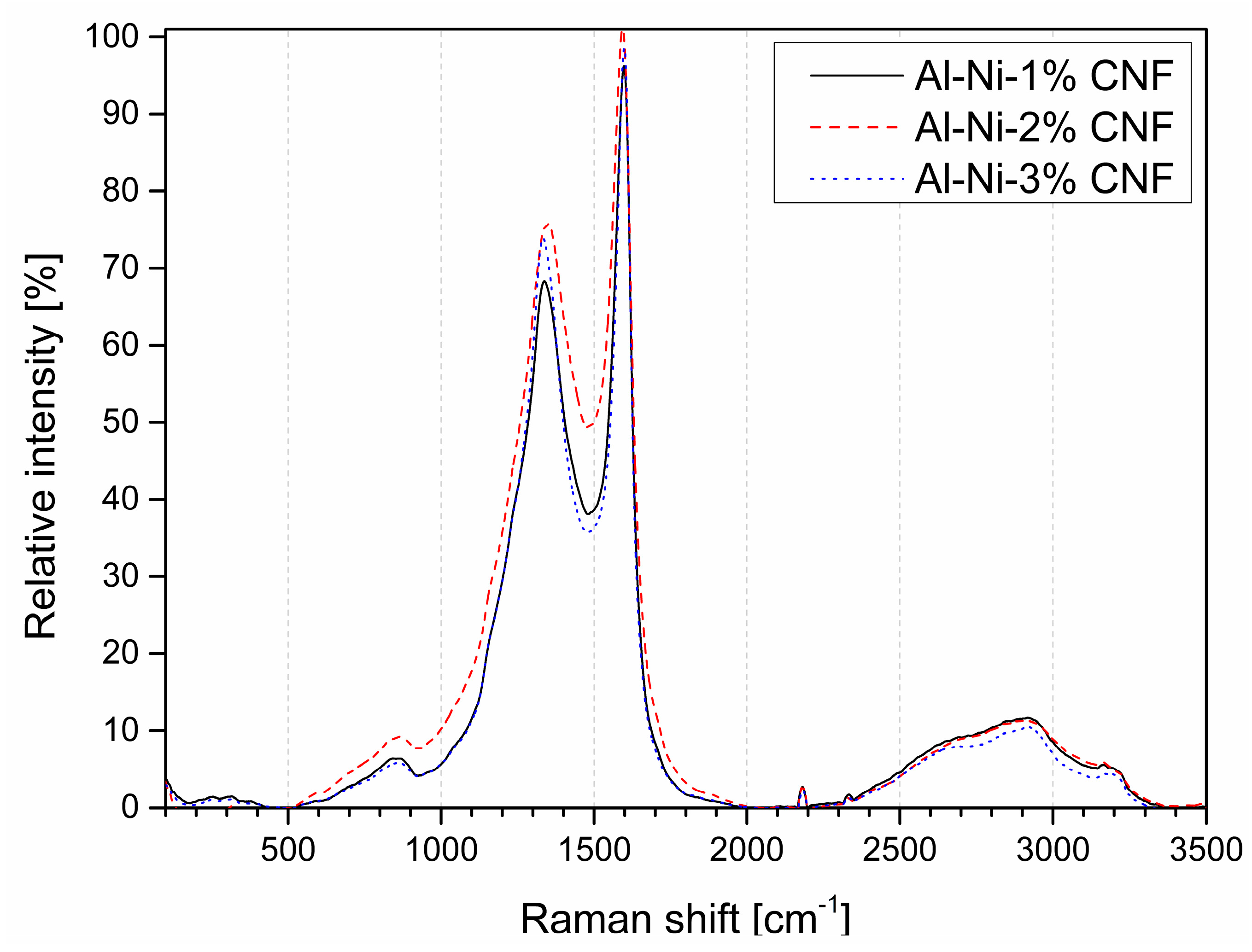
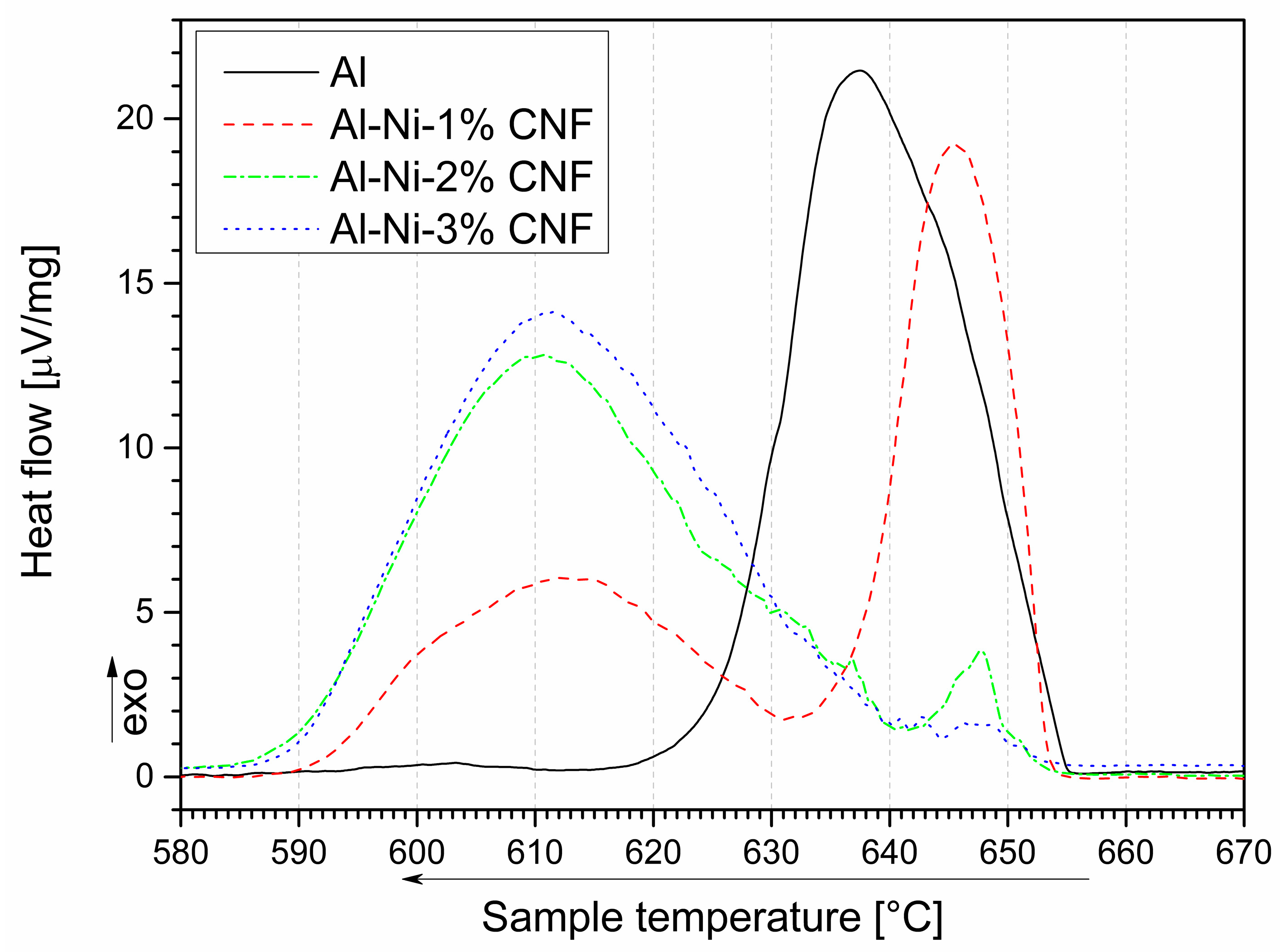
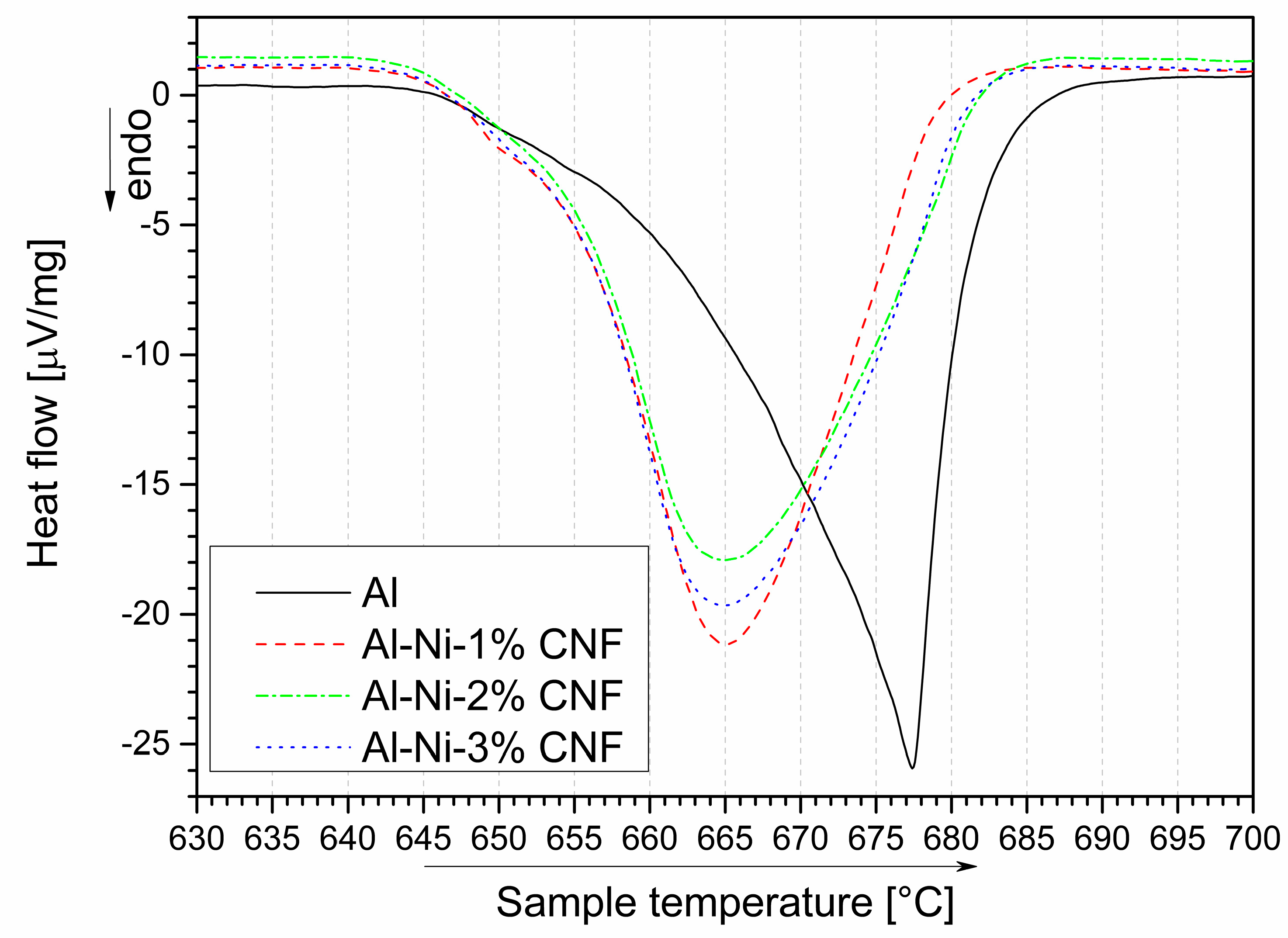
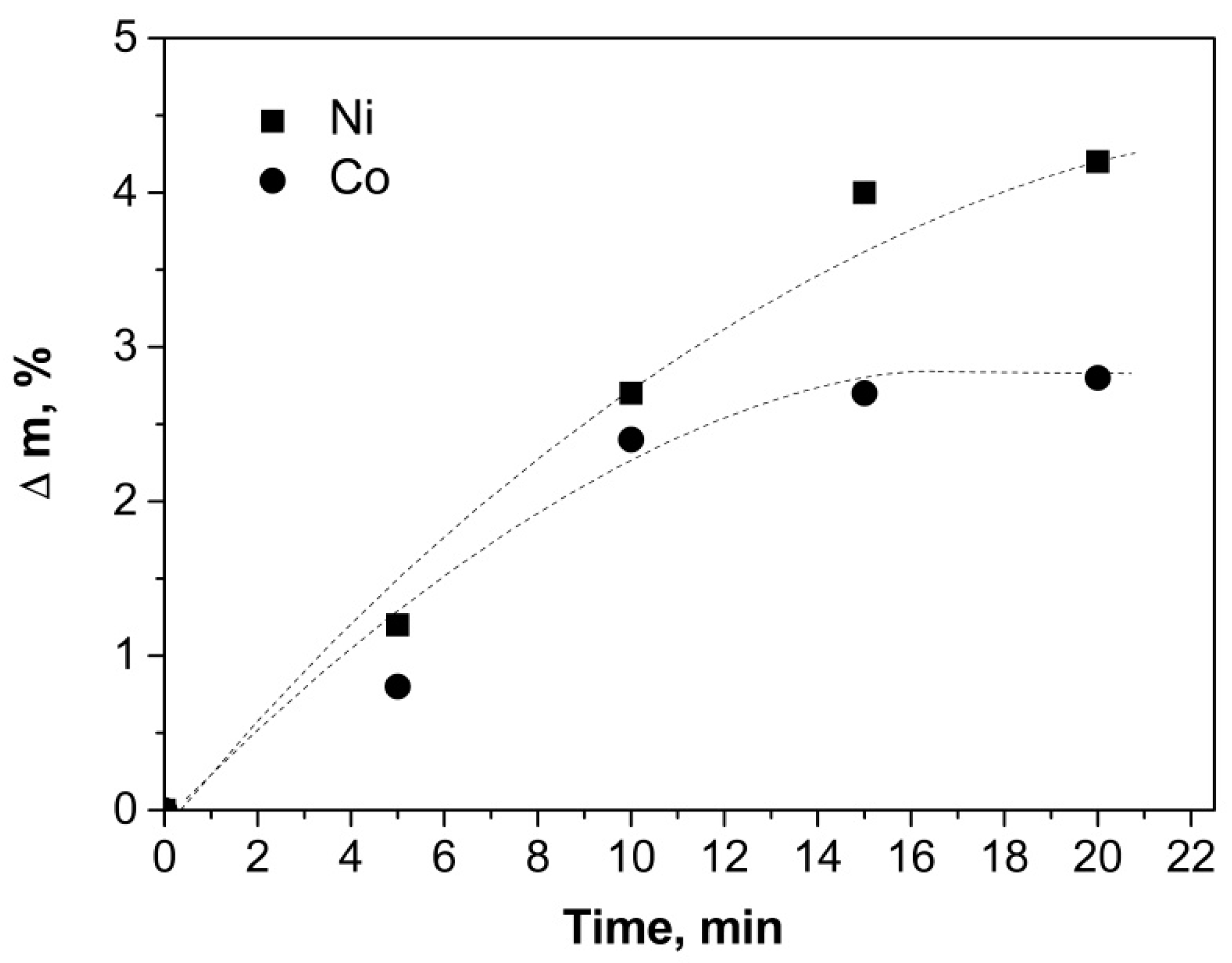
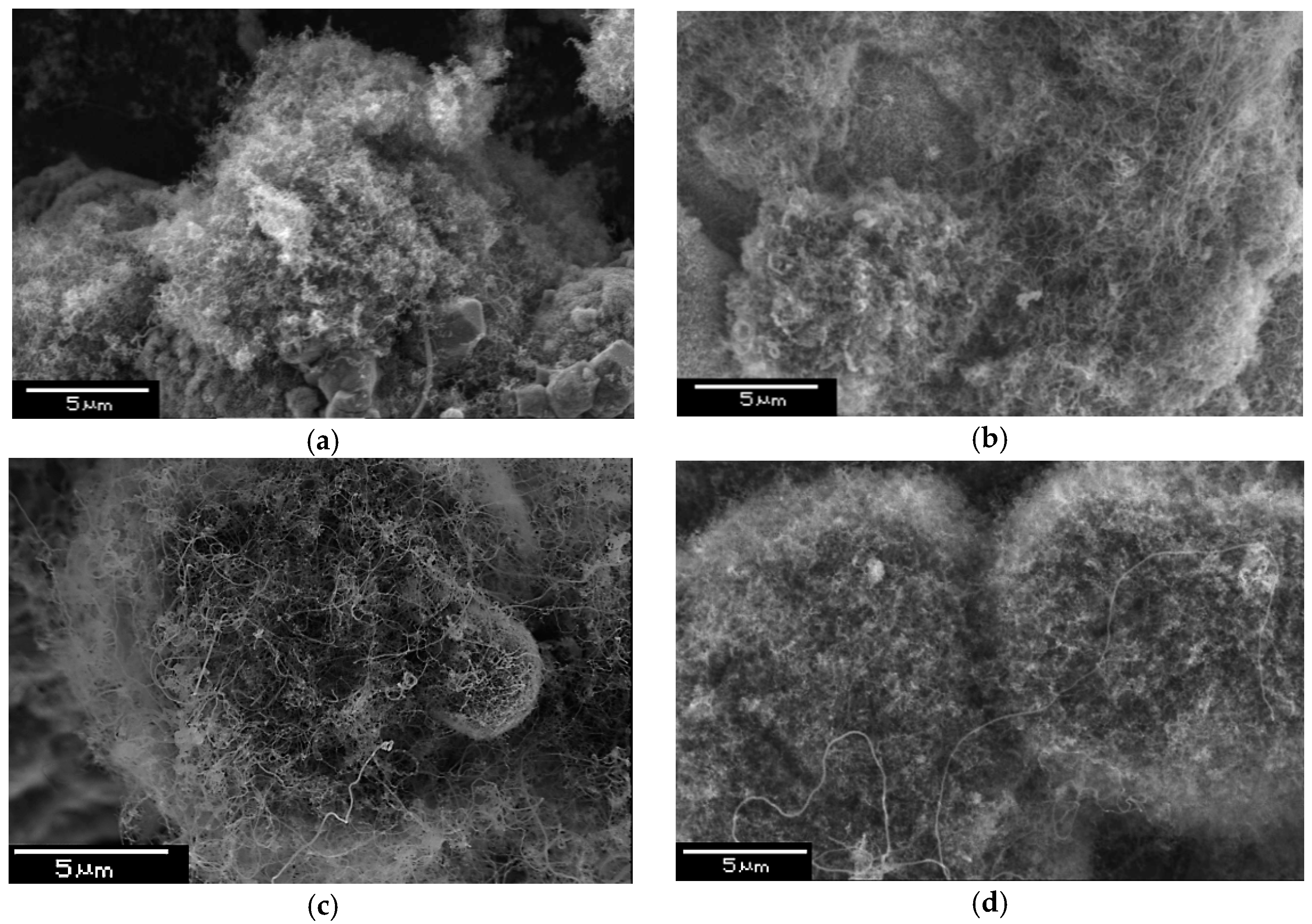

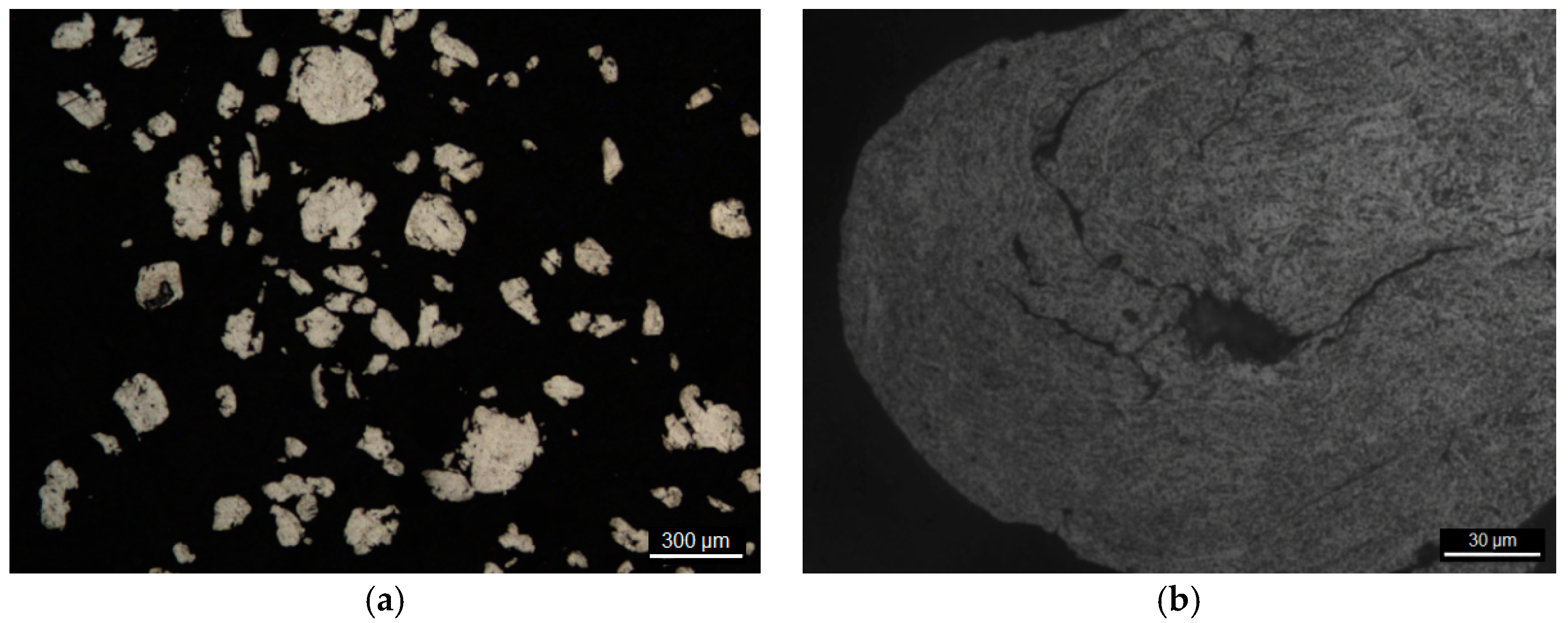
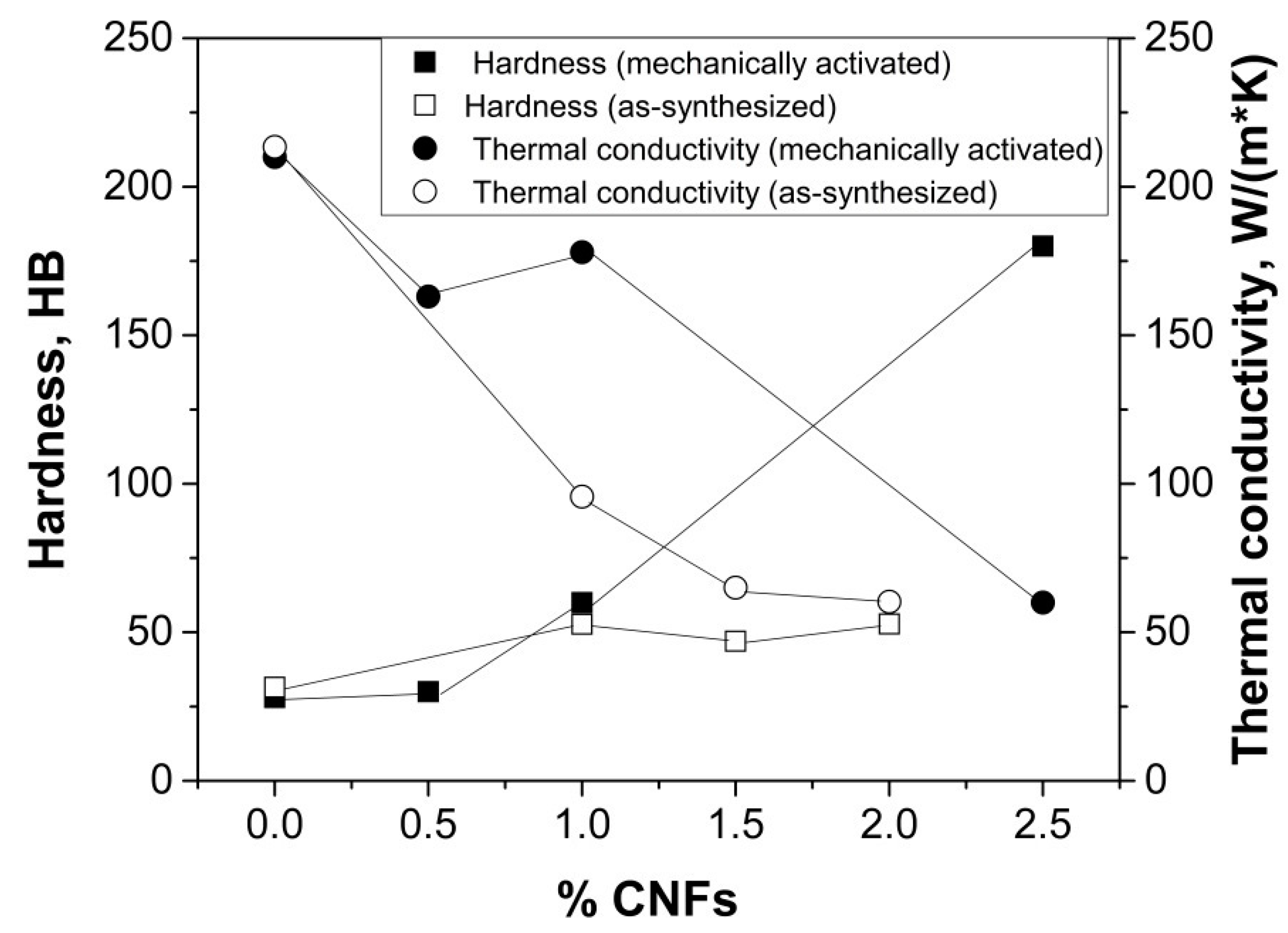
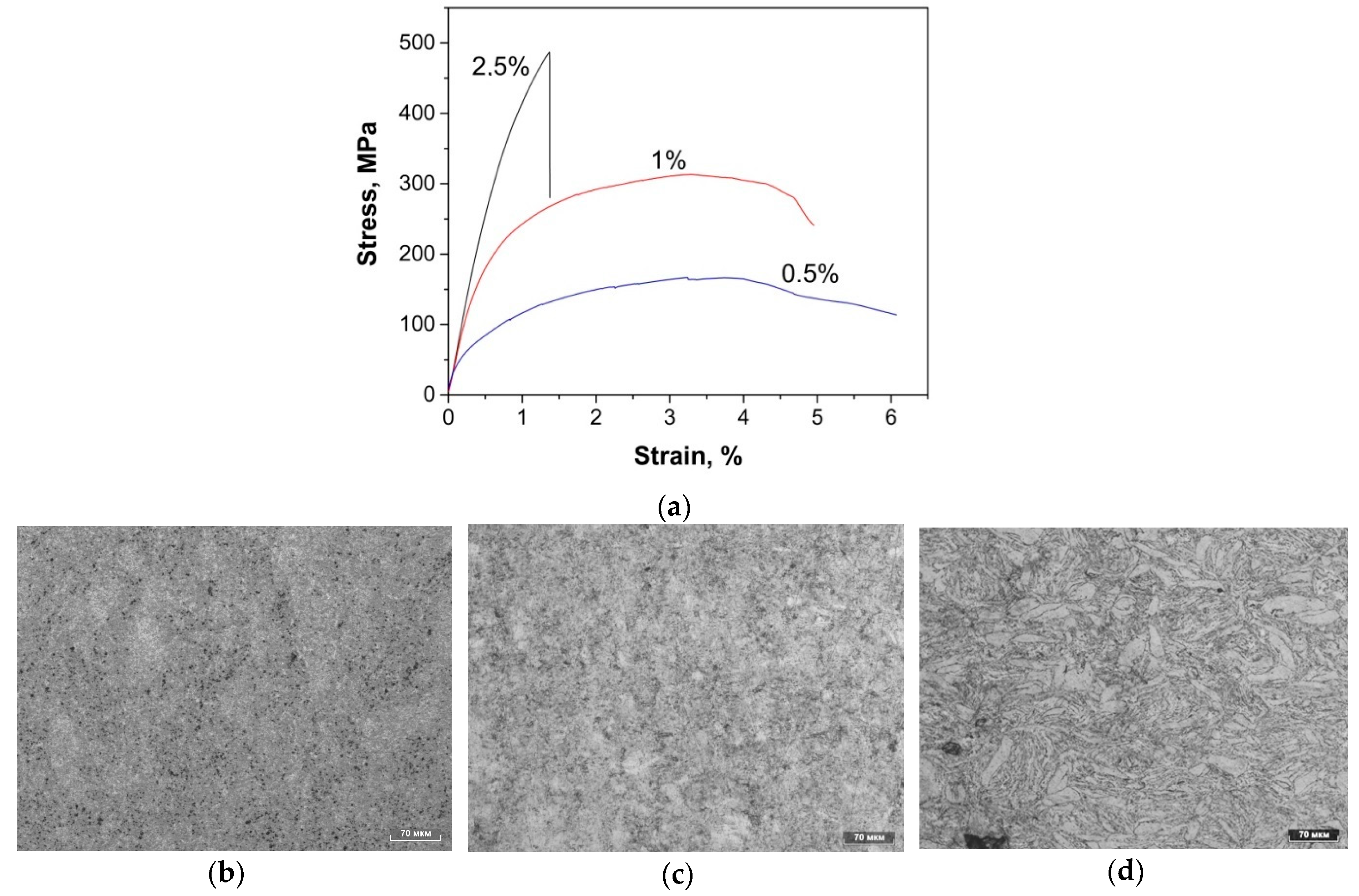
| Specimen | Specific Surface Area, m2/g (BET, Kr, 77 K) | Specific Surface Area, m2/g (BET, N2, 77 K) | Specific Porosity, cm3/g (Gurvich, N2, 77 K) |
|---|---|---|---|
| Al-Ni | 0.125 | - | - |
| Al-Ni-1%CNFs | 3.71 | 3.58 | 0.014 |
| Al-Ni-1%CNFs+flux | 0.42 | 0.42 | 0.003 |
| Al-Ni-2%CNFs | 4.70 | 4.26 | 0.023 |
| Al-Ni-3%CNFs | 5.04 | 3.85 | 0.013 |
© 2019 by the authors. Licensee MDPI, Basel, Switzerland. This article is an open access article distributed under the terms and conditions of the Creative Commons Attribution (CC BY) license (http://creativecommons.org/licenses/by/4.0/).
Share and Cite
Tolochko, O.V.; Koltsova, T.S.; Bobrynina, E.V.; Rudskoy, A.I.; Zemtsova, E.G.; Kirichenko, S.O.; Smirnov, V.M. Conditions for Production of Composite Material Based on Aluminum and Carbon Nanofibers and Its Physic-Mechanical Properties. Nanomaterials 2019, 9, 550. https://doi.org/10.3390/nano9040550
Tolochko OV, Koltsova TS, Bobrynina EV, Rudskoy AI, Zemtsova EG, Kirichenko SO, Smirnov VM. Conditions for Production of Composite Material Based on Aluminum and Carbon Nanofibers and Its Physic-Mechanical Properties. Nanomaterials. 2019; 9(4):550. https://doi.org/10.3390/nano9040550
Chicago/Turabian StyleTolochko, Oleg V., Tatiana S. Koltsova, Elizaveta V. Bobrynina, Andrei I. Rudskoy, Elena G. Zemtsova, Sergey O. Kirichenko, and Vladimir M. Smirnov. 2019. "Conditions for Production of Composite Material Based on Aluminum and Carbon Nanofibers and Its Physic-Mechanical Properties" Nanomaterials 9, no. 4: 550. https://doi.org/10.3390/nano9040550
APA StyleTolochko, O. V., Koltsova, T. S., Bobrynina, E. V., Rudskoy, A. I., Zemtsova, E. G., Kirichenko, S. O., & Smirnov, V. M. (2019). Conditions for Production of Composite Material Based on Aluminum and Carbon Nanofibers and Its Physic-Mechanical Properties. Nanomaterials, 9(4), 550. https://doi.org/10.3390/nano9040550






